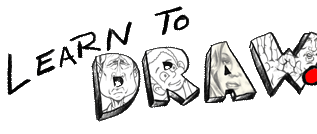|
Do you see that her face still looks a bit flat?
That's because there aren't enough shadows on her face.
The flat areas seem to be the cheek area, the forehead,
and under the chin. We'll put a little bit of shadow on
the shirt, too.
 Very
lightly draw in some shadows around the contours of the
face. I put some around her right cheek, her chin, her
left cheek, and on the right side of the forehead. I
also darkened the lips a touch, and made the line
defining the nose a bit darker at the left lobe. Very
lightly draw in some shadows around the contours of the
face. I put some around her right cheek, her chin, her
left cheek, and on the right side of the forehead. I
also darkened the lips a touch, and made the line
defining the nose a bit darker at the left lobe.
 The
main shadow that needs to be added is the one under the
chin. The light in the photograph is coming from the
upper left, so the shadow under the right jaw is much
thinner and brighter than the shadow being cast under
the left jaw. So as you shade in the shadow on the neck,
make it darker on her left side. The
main shadow that needs to be added is the one under the
chin. The light in the photograph is coming from the
upper left, so the shadow under the right jaw is much
thinner and brighter than the shadow being cast under
the left jaw. So as you shade in the shadow on the neck,
make it darker on her left side.
 The
very last thing to do with this caricature is to put a
bit of shadow on the shirt to define it. The shadows I
use on clothing are sort of a "Z" motion that I vary in
intensity. I just shadow the darker areas to hint at the
shirt. The
very last thing to do with this caricature is to put a
bit of shadow on the shirt to define it. The shadows I
use on clothing are sort of a "Z" motion that I vary in
intensity. I just shadow the darker areas to hint at the
shirt.
 How did your caricature of this woman turn out? I bet it
looks pretty good! Do you see the differences between
caricature and portraiture now? Distorting the face
isn't always giving somebody a monstrously huge nose,
sometimes it's subtle, as this drawing is. Do you see
the difference between the photograph and the caricature
you drew? What makes your drawing a caricature? We moved
her mouth closer to her nose and drew it smaller than it
appears in the photograph. This did a few things: Made
her nose look longer and also makes her chin look longer
as well. In order to draw a good caricature you should
begin to learn to see how you can manipulate the face of
your subject for a humorous effect, while still
maintaining a likeness of your subject. How did your caricature of this woman turn out? I bet it
looks pretty good! Do you see the differences between
caricature and portraiture now? Distorting the face
isn't always giving somebody a monstrously huge nose,
sometimes it's subtle, as this drawing is. Do you see
the difference between the photograph and the caricature
you drew? What makes your drawing a caricature? We moved
her mouth closer to her nose and drew it smaller than it
appears in the photograph. This did a few things: Made
her nose look longer and also makes her chin look longer
as well. In order to draw a good caricature you should
begin to learn to see how you can manipulate the face of
your subject for a humorous effect, while still
maintaining a likeness of your subject.
Continue on
to the next page to see a quick step by step for a
completely different face, and we'll also discuss some
additional ideas in caricature. |
